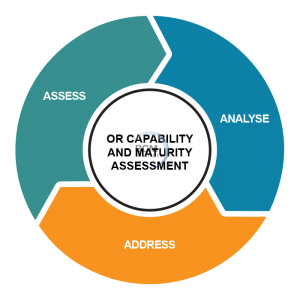From BCMpedia. A Wiki Glossary for Business Continuity Management (BCM) and Disaster Recovery (DR).
Jump to navigation
Jump to search
1. The Three-phase Approach of Capability and Maturity Assessment should follow a three-phase approach: (1) assess, (2) analyze and (3) address.
 OR Capability and Maturity Assessment OR Capability and Maturity Assessment
 Click to know more OR courses Click to know more OR courses
Phase (1): Assess involves:
- assessing the current state of functional capabilities and suitability through various areas within the organisation.
- These include governance, organisational design, technology, process, roles and responsibilities.
- using a scorecard of operational resilience parameters and a radar chart, also known as a web or spider chart
- engaging the senior management and the respective business heads for each vertical unit within the organisation to complete the scorecard.
Phase (2) Analyze is:
- to commence the analysis of the completed scorecards and linked radar charts by the appointed operational resilience team lead
- aim to identify the most critical parameters to start working.
Phase (3) Address is:
- to gather the senior management and the business heads to meet to address the weaknesses.
- the step to collect ideas for improving these areas by using the brainstorming technique.
- the technique of immediately sharing ideas aloud.
- to compile the broad action ideas after the brainstorming.
- to allow the group to drill the ideas down using a decision tree diagram.
- to slot all attainable action items into a Gantt chart to form the improvement roadmap.
Similar Term: Capability Assessment, Capability Level, Maturity Assessment, Maturity Level, Capability and Maturity Assessment
Related Term: Organizational Resilience, Business Continuity Management (BCM), Business Resilience, Cyber Resilience, Data Resilience, Digital Resilience, Relational Resilience, Supply Chain Resilience, Technology Resilience, Operational Resilience.
 Click to know more about expert level training Click to know more about expert level training
|
 A Manager’s Guide to Operational Resilience (eBook)
A Manager’s Guide to Operational Resilience (eBook)



